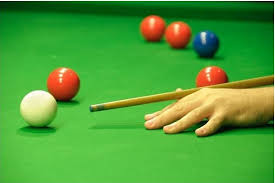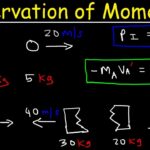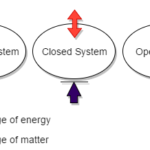Consider a collision between two objects – object 1 and object 2. For such a collision, the forces acting between the two objects are equal in magnitude and opposite in direction (Newton’s third law). This statement can be expressed in equation form as follows.

The forces act between the two objects for a given amount of time. In some cases, the time is long; in other cases the time is short. Regardless of how long the time is, it can be said that the time that the force acts upon object 1 is equal to the time that the force acts upon object 2. This is merely logical. Forces result from interactions (or contact) between two objects. If object 1 contacts object 2 for 0.050 seconds, then object 2 must be contacting object 1 for the same amount of time (0.050 seconds). As an equation, this can be stated as

Since the forces between the two objects are equal in magnitude and opposite in direction, and since the times for which these forces act are equal in magnitude, it follows that the impulses experienced by the two objects are also equal in magnitude and opposite in direction. As an equation, this can be stated as

But the impulse experienced by an object is equal to the change in momentum of that object (the impulse-momentum change theorem). Thus, since each object experiences equal and opposite impulses, it follows logically that they must also experience equal and opposite momentum changes. As an equation, this can be stated as

 The Law of Momentum Conservation
The Law of Momentum Conservation
The above equation is one statement of the law of momentum conservation. In a collision, the momentum change of object 1 is equal to and opposite of the momentum change of object 2. That is, the momentum lost by object 1 is equal to the momentum gained by object 2. In most collisions between two objects, one object slows down and loses momentum while the other object speeds up and gains momentum. If object 1 loses 75 units of momentum, then object 2 gains 75 units of momentum. Yet, the total momentum of the two objects (object 1 plus object 2) is the same before the collision as it is after the collision. The total momentum of the system (the collection of two objects) is conserved.
A useful analogy for understanding momentum conservation involves a money transaction between two people. Let’s refer to the two people as Jack and Jill. Suppose that we were to check the pockets of Jack and Jill before and after the money transaction in order to determine the amount of money that each possesses. Prior to the transaction, Jack possesses $100 and Jill possesses $100. The total amount of money of the two people before the transaction is $200. During the transaction, Jack pays Jill $50 for the given item being bought. There is a transfer of $50 from Jack’s pocket to Jill’s pocket. Jack has lost $50 and Jill has gained $50. The money lost by Jack is equal to the money gained by Jill. After the transaction, Jack now has $50 in his pocket and Jill has $150 in her pocket. Yet, the total amount of money of the two people after the transaction is $200. The total amount of money (Jack’s money plus Jill’s money) before the transaction is equal to the total amount of money after the transaction. It could be said that the total amount of money of the system (the collection of two people) is conserved. It is the same before as it is after the transaction.
A useful means of depicting the transfer and the conservation of money between Jack and Jill is by means of a table.

The table shows the amount of money possessed by the two individuals before and after the interaction. It also shows the total amount of money before and after the interaction. Note that the total amount of money ($200) is the same before and after the interaction – it is conserved. Finally, the table shows the change in the amount of money possessed by the two individuals. Note that the change in Jack’s money account (-$50) is equal to and opposite of the change in Jill’s money account (+$50).
For any collision occurring in an isolated system, momentum is conserved. The total amount of momentum of the collection of objects in the system is the same before the collision as after the collision. A common physics lab involves the dropping of a brick upon a cart in motion.

The dropped brick is at rest and begins with zero momentum. The loaded cart (a cart with a brick on it) is in motion with considerable momentum. The actual momentum of the loaded cart can be determined using the velocity (often determined by a ticker tape analysis) and the mass. The total amount of momentum is the sum of the dropped brick’s momentum (0 units) and the loaded cart’s momentum. After the collision, the momenta of the two separate objects (dropped brick and loaded cart) can be determined from their measured mass and their velocity (often found from a ticker tape analysis). If momentum is conserved during the collision, then the sum of the dropped brick’s and loaded cart’s momentum after the collision should be the same as before the collision. The momentum lost by the loaded cart should equal (or approximately equal) the momentum gained by the dropped brick. Momentum data for the interaction between the dropped brick and the loaded cart could be depicted in a table similar to the money table above.
| Before Collision Momentum | After CollisionMomentum | Change inMomentum | |
| Dropped Brick | 0 units | 14 units | +14 units |
| Loaded Cart | 45 units | 31 units | -14 units |
| Total | 45 units | 45 units |
Note that the loaded cart lost 14 units of momentum and the dropped brick gained 14 units of momentum. Note also that the total momentum of the system (45 units) was the same before the collision as it was after the collision.
Collisions commonly occur in contact sports (such as football) and racket and bat sports (such as baseball, golf, tennis, etc.). Consider a collision in football between a fullback and a linebacker during a goal-line stand. The fullback plunges across the goal line and collides in midair with the linebacker. The linebacker and fullback hold each other and travel together after the collision. The fullback possesses a momentum of 100 kg*m/s, East before the collision and the linebacker possesses a momentum of 120 kg*m/s, West before the collision. The total momentum of the system before the collision is 20 kg*m/s, West (review the section on adding vectors if necessary). Therefore, the total momentum of the system after the collision must also be 20 kg*m/s, West. The fullback and the linebacker move together as a single unit after the collision with a combined momentum of 20 kg*m/s. Momentum is conserved in the collision. A vector diagram can be used to represent this principle of momentum conservation; such a diagram uses an arrow to represent the magnitude and direction of the momentum vector for the individual objects before the collision and the combined momentum after the collision.

Now suppose that a medicine ball is thrown to a clown who is at rest upon the ice; the clown catches the medicine ball and glides together with the ball across the ice. The momentum of the medicine ball is 80 kg*m/s before the collision. The momentum of the clown is 0 m/s before the collision. The total momentum of the system before the collision is 80 kg*m/s. Therefore, the total momentum of the system after the collision must also be 80 kg*m/s. The clown and the medicine ball move together as a single unit after the collision with a combined momentum of 80 kg*m/s. Momentum is conserved in the collision.

Momentum is conserved for any interaction between two objects occurring in an isolated system. This conservation of momentum can be observed by a total system momentum analysis or by a momentum change analysis. Useful means of representing such analyses include a momentum table and a vector diagram. Later in Lesson 2, we will use the momentum conservation principle to solve problems in which the after-collision velocity of objects is predicted.
Check Your Understanding
Express your understanding of the concept and mathematics of momentum by answering the following questions. Click on the button to view the answers.
1. When fighting fires, a firefighter must use great caution to hold a hose that emits large amounts of water at high speeds. Why would such a task be difficult?
See Answer

The hose is pushing lots of water (large mass) forward at a high speed. This means the water has a large forward momentum. In turn, the hose must have an equally large backwards momentum, making it difficult for the firefighters to manage.
close
2. A large truck and a Volkswagen have a head-on collision.
a. Which vehicle experiences the greatest force of impact?
b. Which vehicle experiences the greatest impulse?
c. Which vehicle experiences the greatest momentum change?
d. Which vehicle experiences the greatest acceleration?
See Answer

a, b, c: the same for each.
Both the Volkswagon and the large truck encounter the same force, the same impulse, and the same momentum change (for reasons discussed in this lesson).
d: Acceleration is greatest for the Volkswagon. While the two vehicles experience the same force, the acceleration is greatest for the Volkswagon due to its smaller mass. If you find this hard to believe, then be sure to read the next question and its accompanying explanation.
close
3. Miles Tugo and Ben Travlun are riding in a bus at highway speed on a nice summer day when an unlucky bug splatters onto the windshield. Miles and Ben begin discussing the physics of the situation. Miles suggests that the momentum change of the bug is much greater than that of the bus. After all, argues Miles, there was no noticeable change in the speed of the bus compared to the obvious change in the speed of the bug. Ben disagrees entirely, arguing that that both bug and bus encounter the same force, momentum change, and impulse. Who do you agree with? Support your answer.
See Answer

Ben Travlun is correct.
The bug and bus experience the same force, the same impulse, and the same momentum change (as discussed in this lesson). This is contrary to the popular (though false) belief which resembles Miles’ statement. The bug has less mass and therefore more acceleration; occupants of the very massive bus do not feel the extremely small acceleration. Furthermore, the bug is composed of a less hardy material and thus splatters all over the windshield. Yet the greater “splatterability” of the bug and the greater acceleration do not mean the bug has a greater force, impulse, or momentum change.
4. If a ball is projected upward from the ground with ten units of momentum, what is the momentum of recoil of the Earth? ____________ Do we feel this? Explain.
See Answer

The earth recoils with 10 units of momentum. This is not felt by Earth’s occupants. Since the mass of the Earth is extremely large, the recoil velocity of the Earth is extremely small and therefore not felt.
5. If a 5-kg bowling ball is projected upward with a velocity of 2.0 m/s, then what is the recoil velocity of the Earth (mass = 6.0 x 1024 kg).
See Answer

Since the ball has an upward momentum of 10 kg*m/s, the Earth must have a downward momentum of 10 kg*m/s. To find the velocity of the Earth, use the momentum equation, p = m*v. This equation rearranges to v=p/m. By substituting into this equation,
v = (10 kg*m/s)/(6*1024 kg)
v = 1.67*10-24 m/s (downward)
Another way to write the velocity of the earth is to write it as
0.00000000000000000000000167 m/s
6. A 120 kg lineman moving west at 2 m/s tackles an 80 kg football fullback moving east at 8 m/s. After the collision, both players move east at 2 m/s. Draw a vector diagram in which the before- and after-collision momenta of each player is represented by a momentum vector. Label the magnitude of each momentum vector.
7. In an effort to exact the most severe capital punishment upon a rather unpopular prisoner, the execution team at the Dark Ages Penitentiary search for a bullet that is ten times as massive as the rifle itself. What type of individual would want to fire a rifle that holds a bullet that is ten times more massive than the rifle? Explain.
See Answer

Someone who doesn’t know much physics. In such a situation as this, the target would be a safer place to stand than the rifle. The rifle would have a recoil velocity that is ten times larger than the bullet’s velocity. This would produce the effect of “the rifle actually being the bullet.”
8. A baseball player holds a bat loosely and bunts a ball. Express your understanding of momentum conservation by filling in the tables below.

See Answer

a: +40 (add the momentum of the bat and the ball)
c: +40 (the total momentum is the same after as it is before the collision)
b: 30 (the bat must have 30 units of momentum in order for the total to be +40)
9. A Tomahawk cruise missile is launched from the barrel of a mobile missile launcher. Neglect friction. Express your understanding of momentum conservation by filling in the tables below.

See Answer

a: 0 (add the momentum of the missile and the launcher)
c: 0 (the total momentum is the same after as it is before the collision)
b: -5000 (the launcher must have -5000 units of momentum in order for the total to be +0)



